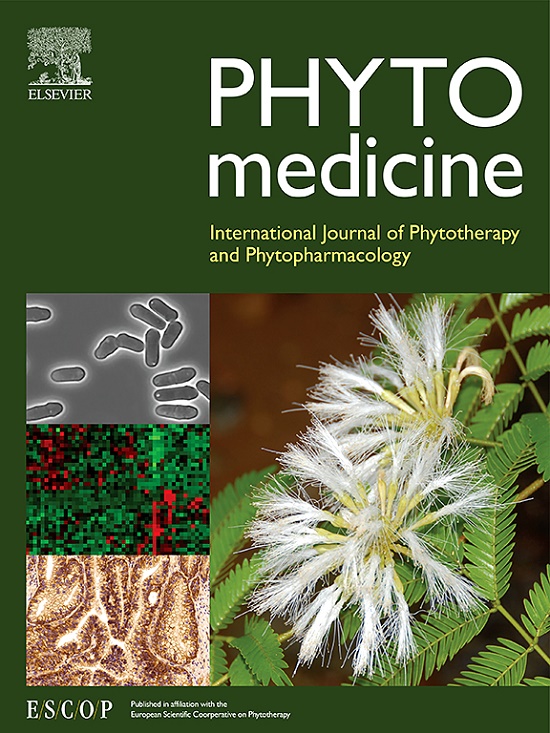Liang-Ge-San attenuates virus-induced acute lung injury by targeting FXR-mediated ACE2 downregulation to modulate the formation of the cytokine storm
IF 6.7
1区 医学
Q1 CHEMISTRY, MEDICINAL
引用次数: 0
Abstract
Background
Traditional Chinese medicine has been recognized for its significant role in treating acute lung injury (ALI) due to its distinct therapeutic advantages. Liang-Ge-San (LGS), a formulation from the ancient “Taiping Huimin Hejiju Fang”, is believed to possess beneficial effects for treating ALI. However, LGS's precise mechanisms and efficacy in addressing viral ALI remain inadequately explored.
Purpose
To evaluate LGS's therapeutic effects and underlying mechanisms in treating viral-induced ALI.
Methods
The protective effects of LGS were examined in a Polyinosinic-polycytidylic acid [Poly(I:C)]-induced ALI model using real-time quantitative PCR, enzyme-linked immunosorbent assay, and histopathological analysis. A bioinformatics approach combined with network pharmacology was utilized to ascertain the key targets of LGS in viral pneumonia. The pharmacodynamic mechanisms of LGS in viral ALI were further validated through immunofluorescence, overexpression, short hairpin RNA, chromatin immunoprecipitation, and target agonist assays.
Results
LGS administration resulted in a reduction of IL-1β, IL-6, and TNF-α levels, along with a decrease in macrophage infiltration, pulmonary damage, and pneumonedema following the Poly(I:C) challenge. Bioinformatics and network pharmacology analyses suggested that Farnesyl X receptor (FXR) and angiotensin converting enzyme 2 (ACE2) are potential therapeutic targets for LGS in viral pneumonia. Further experiments revealed that LGS suppressed the expression of FXR, ACE2, and NF-κB-p65 in Poly(I:C)-infected cells. Notably, overexpression of FXR counteracted the repressive effects of LGS, while ACE2 expression remained unchanged in FXR-knockdown RAW264.7 cells upon treatment with Poly(I:C) or LGS. Additionally, LGS inhibited the interaction between FXR and ACE2 transcriptional promoters. In vivo, LGS attenuated the Poly(I:C)-induced upregulation of FXR, ACE2, IL-1β, IL-6, and TNF-α in ALI zebrafish and mice models, effects that could be reversed by chenodeoxycholic acid (CDCA), an FXR agonist. Moreover, LGS markedly alleviated weight loss, improved survival rates, reduced lung index, diminished viral load, and inhibited lung pathological changes in H1N1-PR8-induced ALI mice. IL-1β, IL-6, TNF-α, INF-γ, FXR, ACE2, small heterodimer partner, and NF-κB-p65 levels were markedly reduced by LGS, with these effects being reversed by CDCA.
Conclusion
This investigation provides the first evidence that FXR/ACE2 signaling is pivotal in acute respiratory viral infections, while LGS demonstrates antiviral activity against viral-induced ALI. LGS inhibits ACE2 expression induced by viral infection via FXR inhibition and modulates the cytokine storm, thus alleviating viral ALI. These findings suggest that LGS may be a promising treatment strategy for treating viral ALI.

求助全文
约1分钟内获得全文
求助全文
来源期刊

Phytomedicine
医学-药学
CiteScore
10.30
自引率
5.10%
发文量
670
审稿时长
91 days
期刊介绍:
Phytomedicine is a therapy-oriented journal that publishes innovative studies on the efficacy, safety, quality, and mechanisms of action of specified plant extracts, phytopharmaceuticals, and their isolated constituents. This includes clinical, pharmacological, pharmacokinetic, and toxicological studies of herbal medicinal products, preparations, and purified compounds with defined and consistent quality, ensuring reproducible pharmacological activity. Founded in 1994, Phytomedicine aims to focus and stimulate research in this field and establish internationally accepted scientific standards for pharmacological studies, proof of clinical efficacy, and safety of phytomedicines.
 求助内容:
求助内容: 应助结果提醒方式:
应助结果提醒方式:


